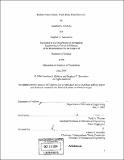Mobile power plants : waste body heat recovery
Author(s)
Gibbons, Jonathan S. (Jonathan Scott), 1979-; Samouhos, Stephen V. 1982-
DownloadFull printable version (3.400Mb)
Other Contributors
Massachusetts Institute of Technology. Dept. of Mechanical Engineering.
Advisor
Todd A. Thorsen.
Terms of use
Metadata
Show full item recordAbstract
Novel methods to convert waste metabolic heat into useful and useable amounts of electricity were studied. Thermoelectric, magneto hydrodynamic, and piezo-electric energy conversions at the desired scope were evaluated to understand their role and utility in the efficient conversion of waste body heat. The piezo-electric generator holds the most promise for the efficient conversion of waste body heat into electricity. In the future, this same device could be easily extended into a combustion based power plant. An experimental apparatus investigating the use of magneto hydrodynamics was designed, built, and tested. A room temperature liquid inetal was propelled through a magneto hydrodynamic channel of 4 inches by 0.1875 inches at a rate of 10 mL/s. A 2 T induction field was applied within the channel. However, the results of the analysis did not find the magneto hydrodynamic device to be an effective electric generator at the scale tested.
Description
Thesis (S.B.)--Massachusetts Institute of Technology, Dept. of Mechanical Engineering, 2004. Includes bibliographical references.
Date issued
2004Department
Massachusetts Institute of Technology. Department of Mechanical EngineeringPublisher
Massachusetts Institute of Technology
Keywords
Mechanical Engineering.